Paleontology
Paleontology is a study of prehistoric life.
Paleontology is a large subject due to the inclusion of fossils from the rock record, taxonomic classification of these fossils, and the occasional find of residual organic material that sometimes contains genetic material.
Theoretical paleontology
Def. the "[s]tudy of the forms of life existing in prehistoric or geologic times"[1] is called paleontology.
Clades from the paleontological rock record sometimes display a clade asymmetry. "(Our two cases of Metazoa and mammals represent the first filling of life's ecological "barrel" for multicellular animals, and the radiation of mammals into roles formerly occupied by dinosaurs.)"[2]
Fossils
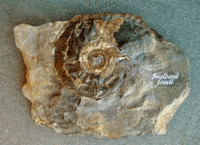
Def. "[t]he mineralized remains of an animal or plant" or "[a]ny preserved evidence of ancient life, including shells, imprints, burrows, coprolites, and organically-produced chemicals"[3] is called a fossil.
Derived terms include ichnofossil, index fossil, living fossil, mesofossil, microfossil, and trace fossil.[3]
Micropaleontology

Micropaleontology is a study of fossil micro-organisms, including foraminifera, which have applications in stratigraphic correlation and age dating along with paleoecology and paleoclimatology.
The image at the right shows microspheric and megalospheric Nummulitid specimens.
Paleobotany
Paleobotany is the study of plant or plant-like fossils.
The image at the right shows fronds impressed onto shale in a specimen on display at the Paläontologische Museum München. The fossil is from Scalby Ness, Scarborough, England.
Palynology
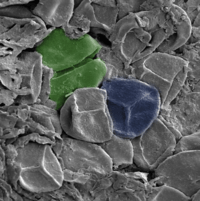
Although regarded as a separate field of its own, in a real sense palynology is the micropaleontological equivalent of paleobotany that involves the study of fossil pollen and spores.
The image at right contains a spore tetrad (in green) of genus Scylaspora and trilete spores (blue, ~30-35μm diameter) from a late Silurian sporangium (Burgsvik beds, Sweden).
Invertebrate paleontology
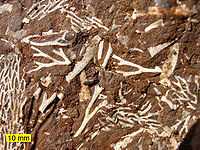
Invertebrate paleontology is a study of fossil invertebrate animals, those which lack a backbone. Included are magafaunas whose study doesn't require a microscope, found in various phyla. Applications include stratigraphic dating and correlation, and paleo-ecology.
At the right is an example of invertebrate paleontology, specifically bryozoan fossils in an Ordovician oil shale from Estonia.
Vertebrate paleontology
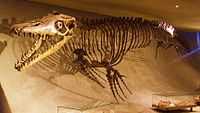
Vertebrate paleontology is any study of prehistoric animals with backbones, e.g. fish of various kinds, marine and terrestrial reptiles, dinosaurs, birds, and mammals.
As a representative of vertebrate paleontology, the image at the right shows a skeleton of Mosasaurus hoffmannii on display at the Natural History Museum of Masstricht.
Geologic time

At right is a geologic clock representation. It shows some of the major units of geological time and definitive events of Earth history. The Hadean eon represents the time before fossil record of life on Earth; its upper boundary is now regarded as 4.0 Ga (billion years ago).[4] Other subdivisions reflect the evolution of life; the Archean and Proterozoic are both eons, the Palaeozoic, Mesozoic and Cenozoic are eras of the Phanerozoic eon. The two million year Quaternary period, the time of recognizable humans, is too small to be visible at this scale.
The following four timelines show the geologic time scale. The first shows the entire time from the formation of the Earth to the present, but this compresses the most recent eon. Therefore the second scale shows the most recent eon with an expanded scale. The second scale compresses the most recent era, so the most recent era is expanded in the third scale. Since the Quaternary is a very short period with short epochs, it is further expanded in the fourth scale. The second, third, and fourth timelines are therefore each subsections of their preceding timeline as indicated by asterisks. The Holocene (the latest epoch) is too small to be shown clearly on the third timeline on the right, another reason for expanding the fourth scale. The Pleistocene (P) epoch. Q stands for the Quaternary period.




Pleistocene
People appear.
Oligocene
The Oligocene Epoch covers 34 - 23 Mya.[5]
"As the Earth began to cool, the tropical plants that had previously been found relatively widespread began to recede towards the equator where it was still warm. The general tropical plants began a transition to more forest like areas. The first grasses also appeared in the late Oligocene. The appearance of these grasses led to to evolution of various herbivore animals. With bodies low to the ground, animals would take advantage of the new grasses that appeared."[5]
Cenozoic
After the dinosaurs became extinct, the Cenozoic began.
Cretaceous
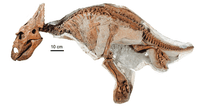
"The Cretaceous period is the third and final period in the Mesozoic Era. It began 145.5 million years ago after the Jurassic Period and ended 65.5 million years ago, before the Paleogene Period of the Cenozoic Era."[6]
The image on the right shows a juvenile Chasmosaurus fossil seen from the side.
"The Ceratopsidae are one of the more immediately recognizable groups of dinosaurs. Characterized by sharp beaks and flamboyant horns and frills, these herbivores almost all lived in what is now Western North America right at the end of the Cretaceous period, 100 to 66 million years ago."[7]
"Chasmosaurus belonged to this group [...] The 75 million-year-old fossilized Chasmosaurus was spotted in 2010 within the Dinosaur Park Formation in Alberta, Canada. In 2013, paleontologists completely unearthed it, and this week, they have described what is undoubtedly a rare specimen."[7]
“For the first time ever, we have a complete skeleton of a baby ceratopsid.”[8]
"Only its forelimbs are completely missing."[7]
"The adult variants are certainly distinctive, with large openings in their head ornaments earning them their appropriate name, which literally means “opening lizard.” Fully grown, they reach a size of up to 4.8 meters (16 feet) and a weight of roughly 2 tonnes (2.2 tons)."[7]
"This juvenile Chasmosaurus is an adorable 1.5 meters (4.9 feet) in length, and would have weighed less than 100 kilograms (220 pounds). It’s so young that its vertebrae had not properly fused, its limbs were not fully articulated (joined up), and it had a particularly short snout. Due to its ornamental opening being fully enclosed by a single bone, scientists have deduced it is likely a species called Chasmosaurus belli."[7]
“We've only had a few isolated bones before to give us an idea of what these animals should look like as youngsters, but we've never had anything to connect all the pieces. All you need is one specimen that ties them all together. Now we have it!”[8]
Jurassic
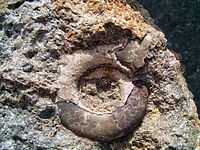
"The Jurassic Period takes place after the Triassic Period and before the Cretaceous Period. This period is well known for the reign of the dinosaurs of its time and the global tropical landscape."[9]
"The Jurassic is a geologic period and system that extends from about 199.6±0.6 Ma (million years ago) to 145.5±4 Ma; that is, from the end of the Triassic to the beginning of the Cretaceous. The Jurassic constitutes the middle period of the Mesozoic Era, also known as the Age of Reptiles. The start of the period is marked by the major Triassic–Jurassic extinction event. However, the end of the period did not witness any major extinction event."[10]
Aalenian
Leioceras opalinum is an ammonite from the Aalenian.
Hettangian
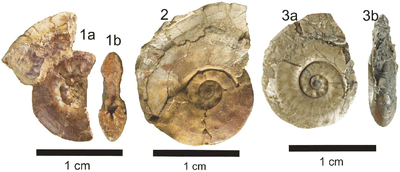
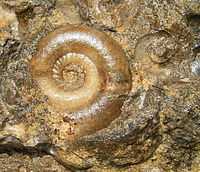
Psiloceras psilonotum, Psiloceras spelae tirolicum and Psiloceras planorbis are from the Hettangian.
Triassic
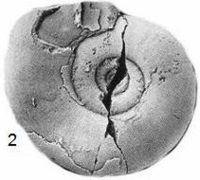
Although the example of Psiloceras tilmanni is from the Jurassic. Its lowest occurrence is in the New York Canyon section of Nevada USA which may be Triassic.
Ladinian
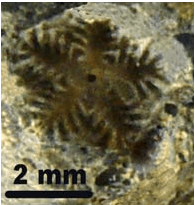
The Atlasov section of the Ladinian contains the crinoid on the right.
Anisian
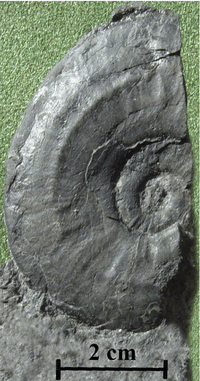
An example of Ussuriphyllites amurensis (Kiparisova) is on the right. It is from the Lower-most Anisian, Atlasov Cape area.[11]
Olenekian
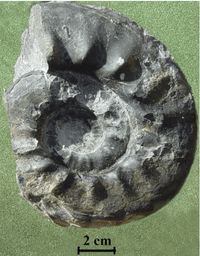
Olenekoceras meridianum is a "typical Late Olenekian [fossil which] differs in its lithology from the same zone of Russian Island, where the Zhitkov Suite has been rec- ognized (Zakharov, 1997; Zakharov et al., 2004)."[11]
Induan
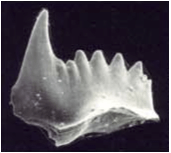
Hindeodus parvus, a conodont, on the right, is now recognized as the index fossil for the Triassic Induan.
Mesozoic
With another mass extinction Mezozoic era started. Now dinosaurs rule.
"A high diversity of terrestrial vertebrates with dinosaurs as the dominant group is strongly indicated but not much of it is yet recorded."[12]
For much of the dinosaur era, the smallest sauropods are larger than anything else in their habitat, and the largest are an order of magnitude more massive than anything else that has since walked the Earth.
Sandbian
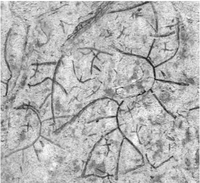
"The Lower Sandbian Nemagraptus gracilis Zone comprises one of the most widespread, and easily recognizable graptolite faunas in the Ordovician System. The base of the N. gracilis Zone also marks the base of the Upper Ordovician Series".[13]
Middle Ordovician
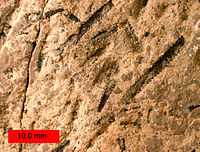
On the right is an image of Amplexograptus sp., probably A. perexcavatus (Lapworth, 1876), from the Middle Ordovician near Caney Springs, Tennessee USA.
Lower Ordovician
Eurypterids
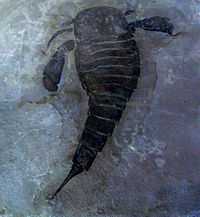
Although present in the Ordovician around 460 million years ago, about 410 million years ago, the first large marine predators (eurypterids), an order of arthropods, experienced a dramatic decline and are extinct.[14]
Guzhangian

"The GSSP level [for the Guzhangian] contains the lowest occurrence of the cosmopolitan agnostoid trilobite Lejopyge laevigata [in the image on the left] (base of the L. laevigata Zone)."[15]
Paleozoic
The mollusks, arthropods, fish, reptiles, and amphibians appeared.
Next 550 mya, after the death of vendobionts, a new era began-the Paleozoic.
After extinction, new spieces named vendobionts appeared.
650 million years ago (mya) a mass extinction happened (mass extinction-is a period when many spieces of animals or plants die).
Proterozoic
First era of prehistoric multicellular life.
Research
To conduct original research in paleontology requires statements of generalization usually using universals. Establishing that a phenomenon has occurred may require a proof of concept. Demonstrating a change from contemporary knowledge needs a control group for comparison.
Hypothesis:
- Ammonites are alive today.
Control groups

The findings demonstrate a statistically systematic change from the status quo or the control group.
“In the design of experiments, treatments [or special properties or characteristics] are applied to [or observed in] experimental units in the treatment group(s).[16] In comparative experiments, members of the complementary group, the control group, receive either no treatment or a standard treatment.[17]"[18]
Proof of concept
Def. a “short and/or incomplete realization of a certain method or idea to demonstrate its feasibility"[19] is called a proof of concept.
Def. evidence that demonstrates that a concept is possible is called proof of concept.
The proof-of-concept structure consists of
- background,
- procedures,
- findings, and
- interpretation.[20]
See also
References
- ↑ "paleontology, In: Wiktionary". San Francisco, California: Wikimedia Foundation, Inc. March 8, 2012. Retrieved 2012-07-22.
- ↑ Stephen Jay Gould, Norman L. Gilinsky and Rebecca Z. German (June 1987). "Asymmetry of lineages and the direction of evolutionary time". Science 236 (4807): 1437-41. doi:10.1126/science.236.4807.1437. http://www.laputan.org/pub/papers/Gould-87.PDF. Retrieved 2011-08-02.
- 1 2 "fossil, In: Wiktionary". San Francisco, California: Wikimedia Foundation, Inc. May 22, 2012. Retrieved 2012-07-22.
- ↑ stratigraphy.org. "International Commission on Stratigraphy 2008". Retrieved 9 March 2009.
- 1 2 Gaidheal1 (April 13, 2011). "Paleogene Period, In: Wikiversity". Retrieved 2012-07-24.
- ↑ Gaidheal1 (May 16, 2012). "Cretaceous Period, In: Wikiversity". Retrieved 2012-07-24.
- 1 2 3 4 5 Robin Andrews (15 January 2016). "Incredibly Preserved 75 Million-Year-Old Baby Dinosaur Discovered". iflscience. Retrieved 2016-01-16.
- 1 2 Philip Currie (15 January 2016). "Incredibly Preserved 75 Million-Year-Old Baby Dinosaur Discovered". iflscience. Retrieved 2016-01-16.
- ↑ Gaidheal1 (April 13, 2011). "Jurassic Period, In: Wikiversity". Retrieved 2012-07-24.
- ↑ "Jurassic, In: Wikipedia". San Francisco, California: Wikimedia Foundation, Inc. 24 July 2012. Retrieved 2012-07-24.
- 1 2 Yuri D. Zakharov, Alexander M. Popov and Galina I. Buryi (April 2005). "Triassic Ammonoid Succession in South Primorye: 4. Late Olenekian – Early Anisian zones of the Atlasov Cape Section". Albertiana 32: 36-9. http://paleo.cortland.edu/Albertiana/issues/Albertiana_32.pdf#page=21. Retrieved 2015-01-24.
- ↑ Alexander Mudroch, Ute Richter, Ulrich Joger, Ralf Kosma, Oumarou Idé, Abdoulaye Maga (February 2011). "Didactyl Tracks of Paravian Theropods (Maniraptora) from the ?Middle Jurassic of Africa". PLoS ONE 6 (2): e14642. doi:10.1371/journal.pone.0014642. PMID 21339816. http://www.plosone.org/article/info%3Adoi%2F10.1371%2Fjournal.pone.0014642. Retrieved 2011-09-14.
- ↑ J.C. Gutiérrez-Marco, D. Goldman, J. Reyes-Abril, and J. Gómez (2011). J.C. Gutiérrez-Marco, I. Rábano and D. García-Bellido. ed. A Preliminary Study of Some Sandbian (Upper Ordovician) Graptolites from Venezuela, In: Ordovician of the World. Madrid: Instituto Geológico y Minero de España. pp. 199-206. ISBN 978-84-7840-857-3. http://digital.csic.es/bitstream/10261/60947/1/ORDOVICIAN%20OF%20THE%20WORLD_199_206.pdf. Retrieved 2015-01-15.
- ↑ Phillip Levin, Donald Levin (January 2002). The Real Biodiversity Crisis. 3270. 3. http://www.americanscientist.org/issues/num2/2002/1/the-real-biodiversity-crisis/3. Retrieved 2011-08-02.
- ↑ Shanchi Peng, Loren E. Babcock, Jingxun Zuo, Huanling Lin, Xuejian Zhu, Xianfeng Yang, Richard A. Robison, Yuping Qi, Gabriella Bagnoli, and Yong’an Chen (March 2009). "The Global Boundary Stratotype Section and Point (GSSP) of the Guzhangian Stage (Cambrian) in the Wuling Mountains, Northwestern Hunan, China". Episodes 32 (1): 41-55. http://www.stratigraphy.org/GSSP/Guzhangian.pdf. Retrieved 2015-01-21.
- ↑ Klaus Hinkelmann, Oscar Kempthorne (2008). Design and Analysis of Experiments, Volume I: Introduction to Experimental Design (2nd ed.). Wiley. ISBN 978-0-471-72756-9. http://books.google.com/?id=T3wWj2kVYZgC&printsec=frontcover.
- ↑ R. A. Bailey (2008). Design of comparative experiments. Cambridge University Press. ISBN 978-0-521-68357-9. http://www.cambridge.org/uk/catalogue/catalogue.asp?isbn=9780521683579.
- ↑ "Treatment and control groups, In: Wikipedia". San Francisco, California: Wikimedia Foundation, Inc. May 18, 2012. Retrieved 2012-05-31.
- ↑ "proof of concept, In: Wiktionary". San Francisco, California: Wikimedia Foundation, Inc. November 10, 2012. Retrieved 2013-01-13.
- ↑ Ginger Lehrman and Ian B Hogue, Sarah Palmer, Cheryl Jennings, Celsa A Spina, Ann Wiegand, Alan L Landay, Robert W Coombs, Douglas D Richman, John W Mellors, John M Coffin, Ronald J Bosch, David M Margolis (August 13, 2005). "Depletion of latent HIV-1 infection in vivo: a proof-of-concept study". Lancet 366 (9485): 549-55. doi:10.1016/S0140-6736(05)67098-5. http://www.ncbi.nlm.nih.gov/pmc/articles/PMC1894952/. Retrieved 2012-05-09.
External links
- African Journals Online
- Bing Advanced search
- GenomeNet KEGG database
- Google Books
- Google scholar Advanced Scholar Search
- Home - Gene - NCBI
- JSTOR
- Lycos search
- NCBI All Databases Search
- Office of Scientific & Technical Information
- Questia - The Online Library of Books and Journals
- SAGE journals online
- Scirus for scientific information only advanced search
- SpringerLink
- Taylor & Francis Online
- WikiDoc The Living Textbook of Medicine
- Wiley Online Library Advanced Search
- Yahoo Advanced Web Search
- Yukon Beringia
- Google Map of the Fossil Sites in Africa
- Google Map of the Fossil Sites in Asia
- Google Map of the Fossil Sites in Europe
- Google Map of the Fossil Sites in North and South America
- Google Map of the Fossil Sites in Antarctica & Oceania
| |||||||||||||||||||||||||||||||||||||||||
| |||||||||||||||||||||||||||||||||||
![]() This is a research project at http://en.wikiversity.org
This is a research project at http://en.wikiversity.org
| |
Development status: this resource is experimental in nature. |
| |
Educational level: this is a research resource. |
| |
Resource type: this resource is an article. |
| |
Resource type: this resource contains a lecture or lecture notes. |
| |
Subject classification: this is a biology resource . |
| |
Subject classification: this is a Geology resource. |